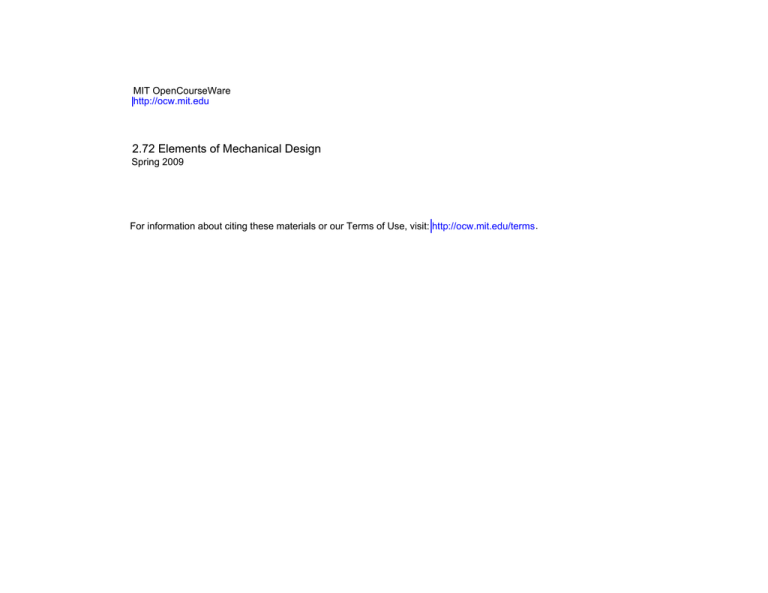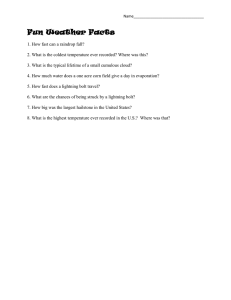
MIT OpenCourseWare
http://ocw.mit.edu
2.72 Elements of Mechanical Design
Spring 2009
For information about citing these materials or our Terms of Use, visit: http://ocw.mit.edu/terms.
2.72
Elements of
Mechanical Design
Lecture 10: Bolted
joints
Bolted joint +’s and –’s
Good:
Low cost?
Able to be disassembled
Strong
Compatible with almost any material
Bad:
Takes up a lot of space
Micro-slip/hysteresis/damping problems
Difficult to model and control
Can require long fabrication and assembly time
© Martin Culpepper, All rights reserved
2
Bolted joints: Their purpose
Bolted joints = connectors, impact many parts:
Stiffness
Vibration
Damping
Stability
Load capacity
Bolted joints are semi-permanent!
Max benefit obtained when it is highly preloaded, i.e. near the yield point
Threads can plastically deform/work harden
Some elements of bolted joints are not reusable
Bolted joints are used to create assemblies that resist:
(i) Tensile loads
(ii) Moments
(iii) Shear loads
Bolts are NOT meant to resist (i) – (iii)
© Martin Culpepper, All rights reserved
3
Components
Anatomy of a bolted joint
l
Grip
Ad
At
Tensile stress area
Major diameter area
tw
HBolt
Ad
L
l
lt
LT
t2
lt
Threaded length in grip
ld
t1
ld
HNut
tw
Unthreaded length in grip
At
d
Major diameter (unthreaded)
© Martin Culpepper, All rights reserved
5
Joint components: Clamped member
Things to consider with the clamped member:
1. Stone or lap the surface (increase
stiffness)
2. Remove burs (increase joint stiffness)
3. Be sure flange surfaces are flat so bolt
does not bend
© Martin Culpepper, All rights reserved
6
Bolted joint components: Bolt
Rolled Threads
NEVER in shear or bending
Head
Keep threads clean &
lubed to minimize losses
Shank
Cut Threads
Steel is most
common
© Martin Culpepper, All rights reserved
Stress concentrations at the
root of the teeth
Fatigue crack propagation!
Exception: Shoulder bolts
~50% power to bolt head
friction
~40% power to thread
friction
~10% power to deforming
the bolt and flange
7
Bolted joint components: Washers
Purpose of Washers:
© Martin Culpepper, All rights reserved
Spacer
Distribute load in clamped member
Reduce head-member wear
Lower coefficient of friction/losses
Lock bolt into the joint (lock washer)
Increase preload resolution (wave washer)
8
Bolted Joint Components: Nut
Threads do not distribute the load evenly:
What can be done to distribute the load better
1. First thread has the shortest load path
(stiffest)
1. Use a softer nut material
2. Use a bolt and nut that have different pitch
plastically
Bolts are values
used once
for with
precision applications
2.Threads
The pitch
of the boltdeform
threads and nut
to begin
threads change as they are loaded
© Martin Culpepper, All rights reserved
3. Use a special nut that lengthens the load
path of the first thread
9
Stiffness
Preload
While preloading joint, are the flange & bolt “springs” in parallel or in series?
Series:
• Same Forces
• Different Displacements (stretches)
Parallel:
• Same Displacements (stretches)
• Different Forces
Fpreload
= Flange Compression
Kflange
Fpreload
= Bolt Stretch
KBolt
© Martin Culpepper, All rights reserved
11
Preloaded joint modeled as series spring
km
kb
Need to find equivalent bolt and member stiffness
© Martin Culpepper, All rights reserved
12
Bolt stiffness
Shoulder bolt/cap screw consists
of two different parts
Ad E
kd =
ld
At E
kt = *
lt
kd
kt
Threaded
Unthreaded
Each has different
Cross sectional area
Axial stiffness
The load passes through both
The effective threaded
grip length, lt*, used in the
stiffness calc is the sum of
the threaded grip length
plus three threads
© Martin Culpepper, All rights reserved
They act in series
This is a series spring calculation
−1
⎛1 1 ⎞
kt k d
kb = ⎜⎜ + ⎟⎟ =
kt + k d
⎝ kt k d ⎠
13
Member stiffness
dw
z
Pressure cone exists in the
member materials and bolt head
The clamping area at the member
interfaces depends upon
α
dh
25o-45o
P dz
dδ =
E A(z )
2
2
⎡⎛
dw ⎞ dh ⎤
A ( z ) = π ⎢⎜ z tan (α ) + ⎟ −
⎥
2
2
⎠
⎢⎣⎝
⎥⎦
© Martin Culpepper, All rights reserved
Washer diameter, dw
Half-apex angle, α
Bore clearance, dh
Stiffness calculation by integration
through the depth of the member
km =
π Ed tan (α )
⎡ ( d w − d h + 2t tan (α ) ) ( d w + d h ) ⎤
ln ⎢
⎥
d
d
2
t
tan
α
d
d
+
+
−
( ) ) ( w h ) ⎥⎦
⎢⎣ ( w
h
14
Loading
Tensile loads in bolted joints
Fi
Preload
External tensile load
Portion of P taken by bolt
P
tw
HBolt
Pb
L
Pm
l
t2
lt
Portion of P taken by members
LT
C
Fraction of P carried by bolt
Fraction of P carried by members
t1
ld
HNut
tw
1-C
© Martin Culpepper, All rights reserved
16
Forces in the bolt and the members
When loaded with a tensile force
Most of the force is taken by the members
Very little (<15%) of the force is taken by the bolt
For most, this is counter intuitive….
P
P
km
P
© Martin Culpepper, All rights reserved
kb
P
17
Forces in the bolt and the members
So how much does each see?
km
Pm = Portion of P taken by members
Pb = Portion of P taken by bolt
kb
kb
Pb =
P=PC
k m + kb
P = Pm + Pb
Pm = P (1 − C )
Pb Pm
δ= =
kb k m
Fb = Pb + Fi
Fm = Pm − Fi
High preload = High load capacity
P,δ
Fb = CP + Fi
Fm = (1 − C )P − Fi
What happens when joint separates?
© Martin Culpepper, All rights reserved
18
Static load capacity
Typically the bolt fails first, why?
CP Fi
+
σb =
At At
It is the least expensive
It is the most easily replaced
Proof load and stress
Sp = proof stress = Limiting value of σb (~ 0.85 σy)
Load factor (like a factor of safety)
C n P Fi
+ = Sp
At
At
n=
n > 1 ensures σb < Sp
S p At − Fi
CP
How high should the pre-load be?
Non-permanent: Some suggest 0.75 Fp
Permanent:
Some suggest 0.90 Fp
© Martin Culpepper, All rights reserved
P
P
P
P
19
Shear resistance
When joint is in shear
Friction between the members takes the load, not the bolt
Coefficient of friction and preload are the important properties
Dowel pins or shoulder bolts should be used to resist shear
P
P
P
P
© Martin Culpepper, All rights reserved
P = μ s Fi
20
Torque,
friction,
preload
Bolt torque and preload
How to measure
Via stretch = but impractical
Via strain = expensive built-in bolt sensor
Via torque = not “ultra-repeatable” but easy and most often used
Relationship between Torque and Stretch?
ETorque = E friction + Estretch
How much do you torque the bolt when tightening?
Too little = weak, compliant joint
Too much = bolt may break or the joint may bulge
Usually torque the bolt until Proof Load is reached
Continuous tightening is important:
© Martin Culpepper, All rights reserved
μ s > μk
22
Best practices
Best practices
D
H >2D
© Martin Culpepper, All rights reserved
Threads should be at
least 1.5 D deep for
bolt to reliably hold a
load
24
Applications: Gasket / roller bearings
Gasket
Roller Bearings
Wave washers can reduce
tightening sensitivity to
achieve desired preload.
© Martin Culpepper, All rights reserved
25
Exercise
Group exercise
The tool holder stiffness is critical to lathe accuracy.
Calculate the stiffness of the bolted joint between your
tool holder and cross slide bearing.
How does the relative stiffness of this compare with the
stiffness of other parts in the load path?
Structure
Bearings
Rails
Etc…
© Martin Culpepper, All rights reserved
27
Preventing Bolts from Coming Loose
How do you prevent bolts from coming loose?
1. Use the joint in a low vibration environment
2. Use bolts with fine threads (small pitch)
3. Use a large preload
4. Use materials with high coefficients of friction
5. Use Loctite on the threads
6. Use an adhesive between the bolt head and flange
7. Use lock washers
N
F
F = μ s*N
© Martin Culpepper, All rights reserved
28
Applications: Bearing Rails
Rails
Carriage
Tighten bolts sequentially
1.5 L
© Martin Culpepper, All rights reserved
L
29
Applications: Bearing Rails
Objectives:
• Maximize stiffness
• Decrease manufacturing cost
• Maximize accuracy
Accuracy is maximized by
overlapping strain cones.
Therefore, the thicker the rail,
the few bolts are necessary.
But the rail becomes less stiff.
Same stiffness
Beware of bulging
High manufacturing
cost
Bolt spacing should be about 4x the
bolt diameter
© Martin Culpepper, All rights reserved
30




